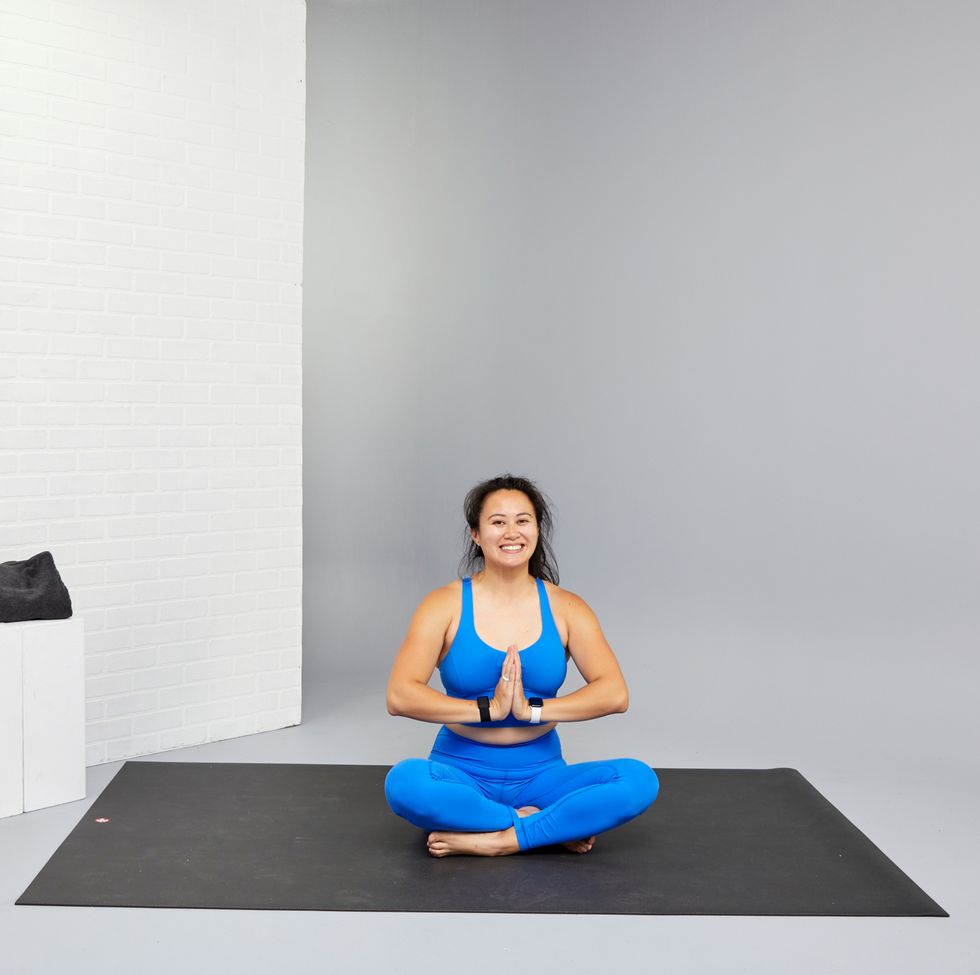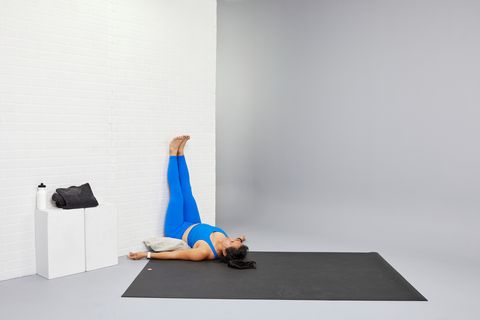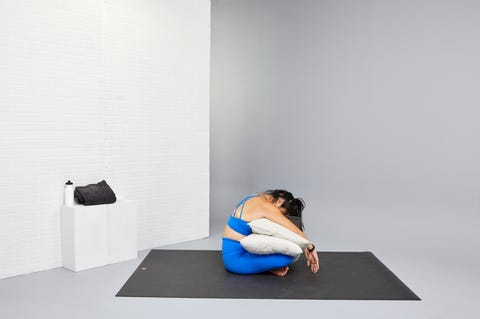
Runners are no strangers to stress. We’re wired to chase faster times, conquer longer distances, and crank out more reps. Our constant drive for progress—or the illusion of it—may explain why we tend to favor active cross-training options like cycling and circuit training. But sometimes, runners would be better off choosing a slow, relaxing activity. This is where restorative yoga can come into play.
Restorative yoga can benefit your running, not only for the physical pay-offs but the mental advantages, too. To get started, learn about what the practice really is (and how it differs from other forms of yoga). Plus, try five restorative yoga poses meant to bring you calm and comfort right at home.
What is restorative yoga?
Restorative yoga is a passive, meditative style of yoga. It involves holding poses for several minutes at a time and incorporates props into those poses, including yoga blocks, bolster pillows, and blankets to keep you supported. These props help you hold poses without tiring or feeling super uncomfortable, which allows your muscles to release any tension you’ve built up with all those miles.
Holding poses for longer periods also gives you the opportunity to focus on your breathing. “Breath and restorative yoga go hand-in-hand,” says Christine Felstead, a 500-hour certified yoga instructor and author of Yoga for Runners. “You don’t want to just hang out in a pose and forget about it. You want to use that time to do some really great diaphragmatic breathing.” (That means deep belly breathing, rather than inhales and exhales only reaching your chest.)
How is restorative yoga different from other types of yoga?
Restorative yoga is the opposite of the fluid yoga styles many studios offer, including flow, power, and hot varieties.
On the surface, restorative yoga most closely resembles another slow-paced style of yoga known as Yin yoga. Both call for holding poses for a longer periods of time (typically three to five minutes) and making use of props. However, there are key differences between restorative and Yin styles of yoga.
“Yin yoga is more of a stretch-based practice,” Felstead says. Each Yin yoga pose is about nudging your muscles and joints deeper toward your end range of motion to increase flexibility and mobility, which can get pretty uncomfortable at times. Imagine stretching as far as you comfortably can, holding that position, and gradually deepening the stretch over the course of a few minutes.
Restorative yoga, on the other hand, “is more about muscle relaxation and letting go than it is about seeking a stretch component,” Felstead says. You relax into each pose, making sure you’re comfortable from the start so you can hold for longer.
What are the benefits of restorative yoga for runners?
Like other forms of the practice, restorative yoga helps increase the mobility and flexibility of your joints and tissues, making it a great addition to your routine. Restorative yoga poses also encourage you to move your muscles and joints in ways you wouldn’t ordinarily move them in running. This can help eliminate muscle tightness and imbalances that contribute to aches, pains, and overuse injuries. “Complementing the repetitive movement of running with other activities is going to go a long way toward keeping you injury-free,” Felstead says.
But one of the primary benefits of restorative yoga—and what sets it apart from other types of yoga—is its focus on total relaxation. This can be especially beneficial for runners who tend to have high-achiever personalities.
“A lot of runners are wired all the time,” Felstead says. Many of us run to disconnect from our busy lives, but then unwittingly turn our running routine into another stressor. We track our pace, distance, heart rate, calories burned, and any other metric we can get our hands on to ensure we’re always making progress.
Tracking progress is great, but couple that stress with the stress of everyday life and you’ve got a nervous system that’s always on high alert. This constant state of readiness can put you at greater risk of high blood pressure, depression, and sleep troubles, according to Harvard Health. “It’s not a surprise that a lot of runners suffer from insomnia,” Felstead notes.
Through deep breathing and supportive poses, restorative yoga helps downregulate your nervous system, or shift it from a sympathetic (“fight-or-flight”) to a parasympathetic (“rest-and-digest”) state. In fact, one 2017 review published in Psychoneuroendocrinology reveals that a mindfulness-based yoga practice can lower stress indicators like cortisol (a stress hormone), blood pressure, and heart rate.
The stress-busting effects of yoga may help runners who struggle with sleep issues, too, according to research. For one 2014 study, researchers had a group of older adults with insomnia attend two weekly yoga classes. After 12 weeks, the yoga group saw significant improvements in sleep quality, sleep duration, and sleep efficiency (measured by the percentage of time in bed that people were asleep) compared to the non-yoga group. While researchers didn’t classify the style as restorative yoga, the classes incorporated elements of restorative yoga, including meditative poses designed to improve mind-body skills like breath awareness. The group also practiced meditative yoga poses at home every day.
5 Restorative Yoga Poses to Try At Home
The following restorative yoga poses from Felstead are ideal for any runner who needs to slow down from time to time (read: all runners). Practice these poses before bed if you struggle to shut off your brain at the end of a stressful day and/or use them to kick-start recovery after a hard run or race.
Make sure you practice diaphragmatic breathing in each pose. To familiarize yourself with diaphragmatic breathing, place one hand just below your rib cage and the other on your upper chest. Breathe in slowly through your nose so you feel your rib cage expand in the front, sides, and back. The hand on your chest should stay still. Exhale slowly and fully through your nose, allowing your ribs and belly to soften and relax.
If any of the poses cause pain, stop or modify the pose.
How to use this list: Complete the following poses in order. Hold each pose for 3 to 5 minutes. (The entire sequence should take you 15 to 25 minutes.) Each move is demonstrated by Rena Eleázar, P.T., D.P.T., C.S.C.S., physical therapist, trainer, and co-founder of Match Fit Performance, so you can master the proper form.
You will need a few pillows, a folded blanket or towel, a yoga block, and a yoga mat is optional.
Legs Up the Wall (Viparita Karani)

How to do it: Place a yoga mat on the floor next to a wall and place a folded blanket or towel next to the wall. Lie faceup and scoot toward the wall until your butt is a few inches away and propped up on the folded blanket or towel. Let hips, back, and head rest on the floor. Extend legs so the backs of heels rest against the wall and let knees bend slightly. Rest arms at sides. Relax and breathe deeply through your diaphragm. Hold, then come out of the pose slowly.
Why it’s great for runners: This pose relieves tired legs by moving the blood back into the body. Plus, elevating your hips with a pillow or blanket helps place your pelvis in a posterior (backward) tilt—the opposite of the anterior (forward) pelvic tilt common in runners, Felstead says. When your pelvis constantly tilts forward, you may experience tightness in the muscles in the front of your pelvis, which can worsen lower back pain.
Supported Bridge (Setu Bandha Sarvangasana)

How to do it: Have a yoga block within reach. Lie faceup on the floor, bend both knees, and place feet flat on the floor hip-width apart. Let arms rest on the floor at sides, palms down. Press feet into the floor and lift hips up, drawing the tailbone upward. Grab the yoga block and slide it under your butt to support hips. Then, press arms and shoulders into the floor to lift chest. Interlace fingers below the yoga block. Relax and breathe deeply through your diaphragm. Hold.
Why it’s great for runners: Many runners tend to let their shoulders round forward — both when running and throughout daily life, Felstead says. This pose can help runners open up their chests and shoulders.
Supported Child’s Pose (Balasana)

How to do it: Stack a few pillows or folded blankets lengthwise in the center of a yoga mat. Kneel behind the stack with toes together and knees hip-width apart. Fold forward to rest torso and head on the pile of pillows or blankets. Let arms hang down so your forearms and palms are flat on the floor. You should feel yourself relax into the pose; add or remove pillows and blankets as needed until you find the right level of support. Relax and breathe deeply through your diaphragm. Hold.
Why it’s great for runners: This position stretches out the hips, thighs, and ankles. It’s also a great pose for releasing tightness in the lower back.
Supported Forward Bend (Paschimottanasana)

How to do it: Sit with your legs extended in front of you and place a stack of pillows and/or folded blankets between legs. Press the top of head toward the ceiling to lengthen spine. Then, keeping spine long, hinge at hips to fold forward over the pillows or blankets. Allow torso and forehead to rest there. Let arms hang down so palms lie flat on the floor. Relax and breathe deeply through your diaphragm. Hold.
Why it’s great for runners: A supported forward bend offers a deep stretch for the entire back of body, from the neck and the spine to the hamstrings and calves.
Modified Savasana

How to do it: Place a yoga mat on the floor next to a couch or soft chair. Lie faceup and scoot toward the couch or chair until you’re able to bend knees and rest calves and feet on the couch or chair. Let your head, back, and arms rest on the floor. Keep hands open, palms up; allow ankles to roll open. Relax and breathe deeply through your diaphragm. Hold, then come out of the pose slowly.
Why it’s great for runners: Yoga classes typically end with savasana, also known as corpse pose. It’s an opportunity to let your entire body relax so you can focus on taking deeper, fuller breaths. Resting your legs on a couch instead of the floor takes some of the strain off your lower back.